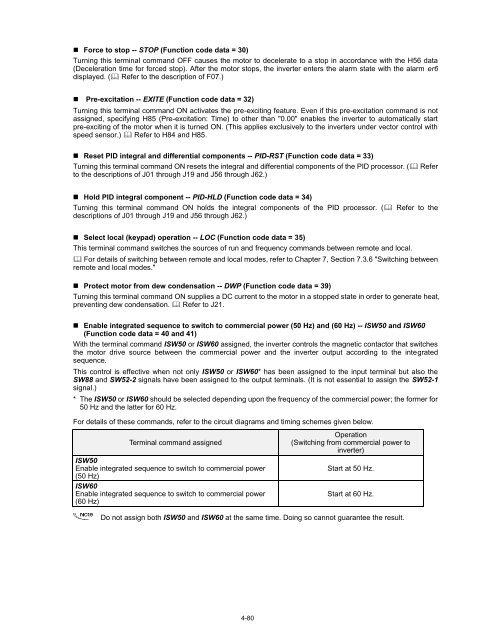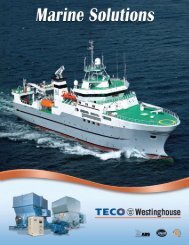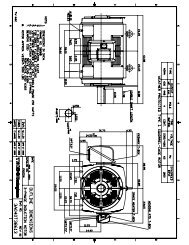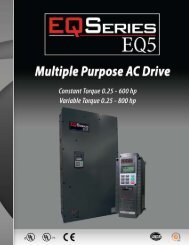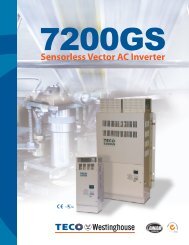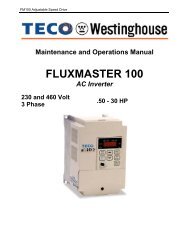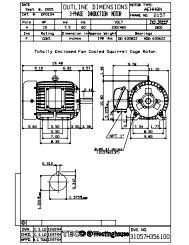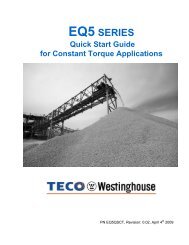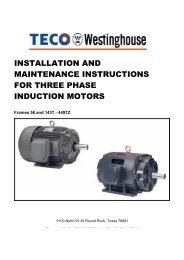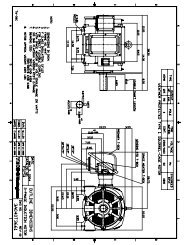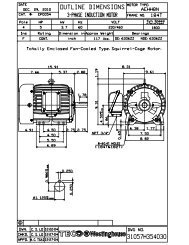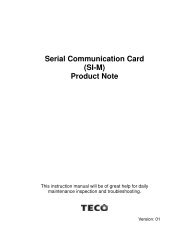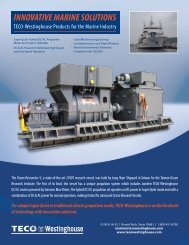EQ7 Series Instruction Manual - TECO-Westinghouse Motor Company
EQ7 Series Instruction Manual - TECO-Westinghouse Motor Company
EQ7 Series Instruction Manual - TECO-Westinghouse Motor Company
Create successful ePaper yourself
Turn your PDF publications into a flip-book with our unique Google optimized e-Paper software.
• Force to stop -- STOP (Function code data = 30)<br />
Turning this terminal command OFF causes the motor to decelerate to a stop in accordance with the H56 data<br />
(Deceleration time for forced stop). After the motor stops, the inverter enters the alarm state with the alarm er6<br />
displayed. ( Refer to the description of F07.)<br />
• Pre-excitation -- EXITE (Function code data = 32)<br />
Turning this terminal command ON activates the pre-exciting feature. Even if this pre-excitation command is not<br />
assigned, specifying H85 (Pre-excitation: Time) to other than "0.00" enables the inverter to automatically start<br />
pre-exciting of the motor when it is turned ON. (This applies exclusively to the inverters under vector control with<br />
speed sensor.) Refer to H84 and H85.<br />
• Reset PID integral and differential components -- PID-RST (Function code data = 33)<br />
Turning this terminal command ON resets the integral and differential components of the PID processor. ( Refer<br />
to the descriptions of J01 through J19 and J56 through J62.)<br />
• Hold PID integral component -- PID-HLD (Function code data = 34)<br />
Turning this terminal command ON holds the integral components of the PID processor. ( Refer to the<br />
descriptions of J01 through J19 and J56 through J62.)<br />
• Select local (keypad) operation -- LOC (Function code data = 35)<br />
This terminal command switches the sources of run and frequency commands between remote and local.<br />
For details of switching between remote and local modes, refer to Chapter 7, Section 7.3.6 "Switching between<br />
remote and local modes."<br />
• Protect motor from dew condensation -- DWP (Function code data = 39)<br />
Turning this terminal command ON supplies a DC current to the motor in a stopped state in order to generate heat,<br />
preventing dew condensation. Refer to J21.<br />
• Enable integrated sequence to switch to commercial power (50 Hz) and (60 Hz) -- ISW50 and ISW60<br />
(Function code data = 40 and 41)<br />
With the terminal command ISW50 or ISW60 assigned, the inverter controls the magnetic contactor that switches<br />
the motor drive source between the commercial power and the inverter output according to the integrated<br />
sequence.<br />
This control is effective when not only ISW50 or ISW60* has been assigned to the input terminal but also the<br />
SW88 and SW52-2 signals have been assigned to the output terminals. (It is not essential to assign the SW52-1<br />
signal.)<br />
* The ISW50 or ISW60 should be selected depending upon the frequency of the commercial power; the former for<br />
50 Hz and the latter for 60 Hz.<br />
For details of these commands, refer to the circuit diagrams and timing schemes given below.<br />
Terminal command assigned<br />
ISW50<br />
Enable integrated sequence to switch to commercial power<br />
(50 Hz)<br />
ISW60<br />
Enable integrated sequence to switch to commercial power<br />
(60 Hz)<br />
Operation<br />
(Switching from commercial power to<br />
inverter)<br />
Start at 50 Hz.<br />
Start at 60 Hz.<br />
Do not assign both ISW50 and ISW60 at the same time. Doing so cannot guarantee the result.<br />
4-80


